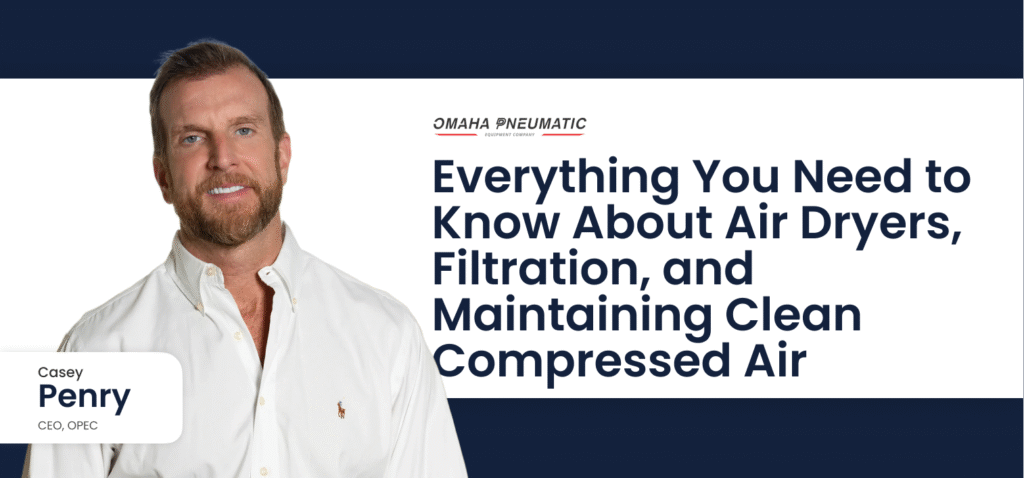Compressed air is an essential part of many industries, powering tools, machines, and even production lines. However, what most people don’t realize is that the quality of this air is crucial. Moisture, oil, and other contaminants can wreak havoc on equipment, reduce productivity, and increase maintenance costs. That’s why understanding air dryers, filtration, and clean air treatment is so important. In this guide, we’ll break down everything you need to know about these key components of compressed air systems in a way that’s easy to understand. Let’s get started!
Why Compressed Air Needs Treatment
When air is compressed, its volume decreases, but the concentration of moisture and contaminants increases. This untreated compressed air can cause several problems:
- Corrosion: Moisture in the air can corrode your equipment, pipes, and tools.
- Shortened Equipment Lifespan: Oil, dust, and debris can cause premature wear and tear on machines.
- Product Contamination: If the compressed air is used in a process that requires clean air, such as food and beverage or pharmaceutical production, contaminants could ruin products.
- Reduced Efficiency: Dirty or wet air can reduce the efficiency of pneumatic systems, increasing energy consumption and downtime.
The Role of Air Dryers
Air dryers are a crucial part of any compressed air system because they remove moisture from the air. This is essential for preventing corrosion, freezing, and other moisture-related issues. There are several types of air dryers, each designed for different applications and environments.
Types of Air Dryers
- Refrigerated Air Dryers
These are the most common types of air dryers used in general industrial applications. Refrigerated air dryers cool the compressed air to condense moisture, which is then drained away. The air is then reheated to prevent condensation in downstream piping. These dryers are ideal for environments where the dew point (the temperature at which moisture begins to condense) doesn’t need to be extremely low. Refrigerated dryers are generally used when a dew point of around 35-40°F is acceptable. - Desiccant Air Dryers
Desiccant dryers are used when much lower dew points are needed, typically in the -40°F range. They use a drying agent, or desiccant, to absorb moisture from the air. Desiccant dryers are often used in industries where moisture-sensitive equipment or processes are involved, such as chemical or pharmaceutical manufacturing. Though highly effective, these dryers can be more expensive and require more maintenance than refrigerated dryers. - Membrane Air Dryers
Membrane air dryers use a permeable membrane to separate moisture from the compressed air. These dryers are highly reliable, require no electricity, and have no moving parts, making them very low maintenance. They are best suited for small applications where a moderate dew point is sufficient. - Deliquescent Air Dryers
In these dryers, a hygroscopic substance (a material that absorbs moisture) dissolves as it absorbs water from the air. The water is then drained away. Deliquescent dryers are simple and effective, but they don’t provide as low a dew point as desiccant or refrigerated dryers. They are often used in applications like outdoor construction or mining.
The Importance of Filtration
Even after air is dried, it can still contain harmful contaminants like oil, dirt, and bacteria. This is where filtration comes in. Filters help clean the air by removing these impurities, protecting your equipment, and ensuring the quality of your end product.
Types of Filters
- Particulate Filters
These filters are designed to remove solid particles like dust, dirt, and rust from compressed air. They are typically the first line of defense and are installed upstream of other filtration devices. Particulate filters protect your equipment from debris that could cause clogging or damage. - Coalescing Filters
Coalescing filters are designed to remove oil and water aerosols from the air. They work by forcing the tiny liquid droplets to merge, or coalesce, into larger droplets, which are then drained away. These filters are essential for protecting equipment that is sensitive to oil contamination, like pneumatic tools or machines that require clean, oil-free air. - Activated Carbon Filters
Activated carbon filters remove oil vapors and odors from compressed air. They are used in applications where air purity is critical, such as in food and beverage processing or pharmaceuticals. Activated carbon absorbs the vapor, ensuring that the air is clean and odorless. - Sterile Filters
These filters remove bacteria and other microorganisms from the compressed air, making them essential in industries like healthcare, biotechnology, and food processing. Sterile filters ensure that the air remains free from contaminants that could pose health risks.
Clean Air Treatment Solutions
In addition to air dryers and filters, there are several other components and systems designed to ensure the cleanliness and quality of your compressed air.
- Air Receivers
Air receivers are tanks that store compressed air and help remove some moisture and particulates. They also act as a buffer between the compressor and the air distribution system, reducing pressure fluctuations and allowing the compressor to run more efficiently. - Drain Systems
Moisture and contaminants that collect in filters, air dryers, and air receivers need to be removed. Automatic drain systems ensure that water and oil are continuously drained from the system without interrupting operation. Manual drains are also an option, though they require regular maintenance to ensure proper function. - Oil-Water Separators
Oil-water separators are designed to separate the oil from the water that is drained from the system. This is especially important for environmental compliance, as disposing of oily wastewater improperly can lead to hefty fines. - Point-of-Use Cleaners
Point-of-use cleaners ensure that air delivered to a specific application is as clean and dry as necessary. These units can be installed at the end of a compressed air line to provide additional filtration or drying just before the air is used.
How to Choose the Right Air Treatment Solution
Selecting the right combination of air dryers, filters, and other clean air treatment solutions depends on several factors:
- Application Requirements
If your process is sensitive to moisture or oil, you’ll need more advanced filtration and drying systems. On the other hand, general manufacturing processes may not require such stringent standards. - Operating Conditions
The ambient temperature, humidity, and air pressure will affect the type of dryer and filtration system you need. For example, in hot or humid environments, a refrigerated dryer might struggle to reach the necessary dew point, so a desiccant dryer might be a better choice. - Cost and Maintenance
While advanced systems provide cleaner air, they also come with higher costs and more maintenance requirements. It’s essential to weigh these factors against the needs of your equipment and processes. - Environmental Considerations
Don’t forget about environmental regulations and waste management. Systems that generate a lot of waste or require frequent disposal of oil and water should be carefully managed to avoid fines and environmental damage.
Last Thought
Clean, dry, and contaminant-free compressed air is essential for maintaining efficient operations, protecting your equipment, and ensuring product quality. Understanding the role of air dryers, filtration, and clean air treatment in your system is key to making informed decisions. By choosing the right solutions based on your needs, you can keep your equipment running smoothly and avoid costly downtime and repairs.




